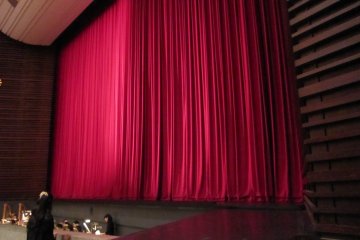
Ueno: Tokyo Bunka Kaikan
Takako SakamotoTokyo Bunka Kaikan is Japan's oldest 'Palace' of music and ballet. In 1961, the Tokyo Metropolitan Government constructed it as part of its 500th anniversary celebration. It is located just inside Ueno Park

Tokyo Bunka Kaikan is a renowned concert hall located in Ueno Park, the green heart of Taito Ward. The hall opened in 1961 as a hub for arts and culture and has since played host to numerous operas, ballets, and classical concerts by both Japanese and international artists.
The building itself is a feat of modern architecture and was designed by architect, Kunio Maekawa. The main hall, which features opera, ballet, and orchestral performances, is an impressive five stories high and contains 2,303 seats. Its modern interior is visually stunning, and its acoustics are world-renowned. The smaller recital hall, located on the second floor, has 649 seats and hosts almost daily chamber music concerts and recitals.
In addition to its performance halls, Tokyo Bunka Kaikan is also home to an extensive music library, meeting rooms, rehearsal rooms, a restaurant, a cafe, a gift shop, and a Japanese goods and accessories store.
In theme with its mission to promote the arts, the facility holds multiple workshops, competitions, and professional development programs to encourage and facilitate artistic learning.
Tokyo Bunka Kaikan is about a 5-minute walk from Ueno Station. To reach Ueno Station from Tokyo Station, simply take the Yamanote Line (11 mins).

Tokyo Bunka Kaikan is Japan's oldest 'Palace' of music and ballet. In 1961, the Tokyo Metropolitan Government constructed it as part of its 500th anniversary celebration. It is located just inside Ueno Park
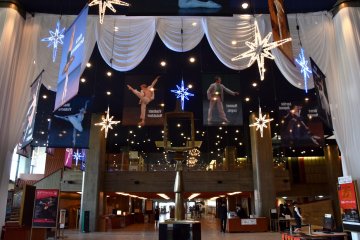
The World Ballet Festival in Tokyo: the brilliant top dancers of the world get together at Tokyo Bunka Kaikan in Ueno once every three years!

Tokyo Bunka Kaikan, 'The Music Palace', is a classical music hall built in 1961. Located inside the Ueno Park, it holds concerts ranging from classical music, to opera, to ballet.

If you've ever attended a classical music performance but found it a bit stuffy and not suitable for kids, there is a solution – Zoorasian Brass. This group was founded in 2000 with the goal of performing classical music inspired by picture book characters.

First held in 1976, the World Ballet Festival is a multi-week event in Tokyo that brings together the world’s most talented dancers.

NOHGA HOTEL AKIHABARA TOKYO is conveniently located in the midst of the electric town Akihabara, also known as the capital of manga and anime. In addition, this neighborhood has an abundance of tech shops, maid cafes and a variety of restaurants. With just a 6-minute walk away from Akihabara station, it provides easy access to explore other areas nearby such as Ueno and Asakusa. This hotel embodies the rich cultures of music, art and food. Nohga’s concept of music is derived from Akihabara’s local history, starting as a district of radio and wireless component merchants in the late 1920s. The artistic and luxurious space throughout the hotel is achieved by featuring art and amenities designed in collaboration with craftsmen from around Japan. As for the food menu, it’s seasonal fresh ingredients are sourced domestically. The glasses and dinnerware served are collaborations with stores in the surrounding area. All 120 non-smoking guest rooms feature an ensuite bathroom with a rain shower, in-room safety box, mini fridge, USB plugs, free Wi-Fi, a high-quality bluetooth speaker and flatscreen TV with original music and film. The lounge area and a compact 24-hour gym can be found near the reception on the second floor. Services include laundry (from 2,750JPY) and a 24-hour front desk with a check-in time of 3PM and check-out time of 11AM. For sightseeing you can rent a Tokyobike for the day (2,000 JPY/day) to explore the vicinity.

Oakwood Premier Tokyo comes from a brand of standout luxury hotel & service apartments right at the heart of the Tokyo metropolis. It is located in the business hub of Marunouchi with JR Tokyo Station in close proximity. This will allow guests and travelers to easily access the city's extensive transport network and visit various landmarks such as Imperial Palace, Tsukiji Fish Market, Ginza and Shopping District. Boasting 123 luxurious apartments on the upper floors of a multi-serviced complex, each room offers a magnificent view of the city, not to mention all furnished and a fully-equipped kitchen set which is rarely seen in your everyday service apartment. Without doubt, these spacious tranquil retreats are curated to give you the amenities and services of a luxury hotel and a feeling of home. They are good options for both business executives and leisure travelers from one night of a short-stay to a few weeks/months of mid-to-long-term stay.
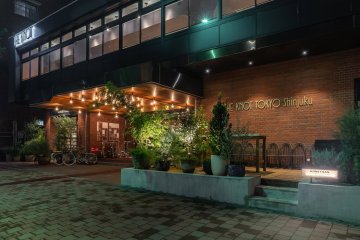
Located right next to Shinjuku Chuo Park, THE KNOT TOKYO Shinjuku is a modern hotel with an exceptional design and easy access to the nearby Shinjuku train station and the Meiji Shrine. The 14-story hotel building was renovated and reopened in August 2018 as THE KNOT TOKYO Shinjuku . The western-style rooms offer a park view on the top floor as well as a newly opened terrace suite. The spacious atrium design offers a relaxed atmosphere and connects the restaurant, bar, lounge and lobby with one another. One of the highlights of THE KNOT is the delicious dishes. There are six areas in which food and drinks are offered. From the grill area to high-quality black tea and fresh bread, everything is on offer.

Bunny Cafe Moff Rell in Tokyo's Chiyoda Ward offers a chance to interact with adorable rabbits. You can make reservations for the cafe by phone, or you can visit and pay at the store before entering. The cafe provides 30- and 60-minute courses, and you can play with or feed the bunnies. If you are unsure about how to treat the rabbits, don't worry! The staff members will kindly explain everything to you. Minimum age is 10 years old.

Ayam-YA is a certified halal ramen restaurant found in the Okachimachi area of Tokyo, between Asakusa and Ueno, and not far from Assalaam Mosque. A sister branch in Kyoto also exists.

PIZZERIA & BAR NOHGA is an all day dining restaurant interpreting a fusion of “Spanish Italian” cuisine and has a kitchen to table design. There is a casual bar area and restaurant where you can take a peek inside the open kitchen whilst enjoying your meal. Visit the cafe for a range of coffees and teas along with an offering of tapas snacks and seasonal desserts. The cafe also offers an assorted dessert and all-you-can-drink cafe set. Breakfast takes on the art of sharing, where a range of platters are combined with focaccia and your choice of eggs cooked your way. Coming for lunch? Choose from a selection of pizzas, pastas and salads. Each lunch menu is accompanied with homemade soup, iced tea and focaccia. Dinner time offers a range of exquisite tapas and pizzas that can also be shared. Breakfast: 07:00 - 10:00, Lunch 11:30 - 14:30, Cafe 14:30 - 18:00, Dinner: 18:00 - 23:00 with last order at 10pm.
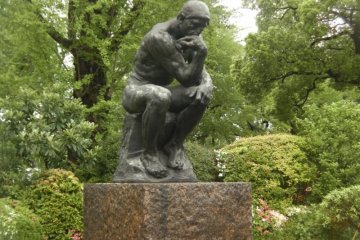
The National Museum of Western Art is the premier public art gallery in Japan specializing in art from the Western tradition. The museum is in the museum and zoo complex in Ueno Park in Taito, central Tokyo. It received 1,162,345 visitors in 2016. Wikipedia

The National Museum of Nature and Science is in the northeast corner of Ueno Park in Tokyo. Opened in 1871, it has had several names, including Ministry of Education Museum, Tokyo Museum, Tokyo Science Museum, the National Science Museum of Japan, and the National Museum of Nature and Science as of 2007. [Wikipedia]
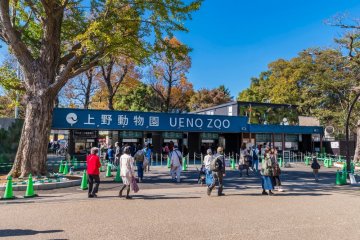
Ueno Zoo is the oldest zoo in Japan and one of Ueno's greatest attractions. The zoo began as a collection of wild animals affiliated with the National Museum of Natural History and first opened as a public zoo on March 20, 1882. The zoo has expanded significantly since then and is now home to over 3,000 animals and 400 different species. The attraction of Ueno Zoo, however, is the pandas, also because they have successfully reproduced. Ueno Zoo is actively committed to the conservation of wild animals. The zoo is divided into two sections, a west and an east park, each with different animal species. The two areas are connected by a bridge. To the east are the pandas, Asian elephants, large numbers of bears and larger mammals like gorillas, tigers and lions. In the west area there is a petting zoo and a reptile and amphibious house. This area also focuses on animals from Africa: rhinos, hippos, giraffes and zebras. A five-story pagoda and a tea house from the 17th century round off the visit to the zoo and give this historic zoo a typically Japanese touch.